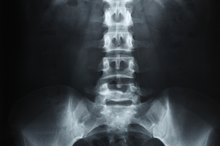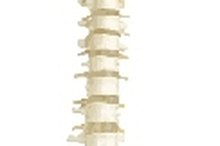What Is Neural Foraminal Narrowing?
Neural foraminal narrowing, often referred to as neural foraminal stenosis, is a condition that affects the spinal cord and the associated spinal nerves. The condition is due to a narrowing of the foramen, resulting in eventual nerve compression.
Identification
Spinal nerves pass through openings in the spinal cord called neural foramina. Various conditions or diseases cause the openings to narrow, causing compression of the nerves passing through the openings.
Causes
What Is Left Foraminal Stenosis?
Learn More
Disc degeneration, due to the natural wear and tear of aging, is the most common cause of neural foraminal narrowing. Narrowing of the foramen may also be due to rheumatoid arthritis, osteoarthritis, chronic meningitis or tumors in the spinal column. Less often, the condition is congenital, or present at birth.
Symptoms
The nerve compression resulting from neural foraminal narrowing is generally a slow and gradual process. Pain, numbness, tingling and muscle weakness are the most common symptoms. Symptoms are generally noncontinuous and vary depending on whether it's cervical or lumbar spinal compression.
Treatment
Stocking & Glove Neuropathy
Learn More
Treatment options vary depending on the severity of the symptoms. Nonsurgical treatment is the first choice to relieve symptoms and includes physical therapy, anti-inflammatory medications, lifestyle alterations or steroid injections. Decompression surgery is generally the only option for complete resolution, and several minimally invasive surgery options exist.
Diagnosis
According to The Spinal Columns, neural foraminal narrowing can be difficult to diagnose because of the gradual and noncontinuous nature of symptoms. Along with a complete medical history, a physician will generally use diagnostic imaging to diagnose neural foraminal narrowing.
Related Articles
References
- SpinalDisorders.com
- Cleveland Clinic. Spinal stenosis: Overview. Updated August 17, 2020.
- Cleveland Clinic. Spinal stenosis: Overview. Updated August 17, 2020.
- American Academy of Orthopedic Surgeons. Lumbar spinal stenosis. Updated December 2013.
- MedlinePlus. Foraminotomy. Updated November 5, 2018.
- Cleveland Clinic. Spinal stenosis: Overview. Updated August 17, 2020.
- Lurie J, Tomkins-lane C. Management of lumbar spinal stenosis. BMJ. 2016;352:h6234. doi:10.1136/bmj.h623
- Cleveland Clinic. Spinal stenosis: Overview. Updated August 17, 2020.
Resources
Writer Bio
Jason Dority has been writing health-related articles and developing community resources for healthier lifestyles since 2007. He currently works for the Indiana University School of Medicine's Diabetes Translational Research Center. Dority holds a Master of Science in biology from Indiana University.








